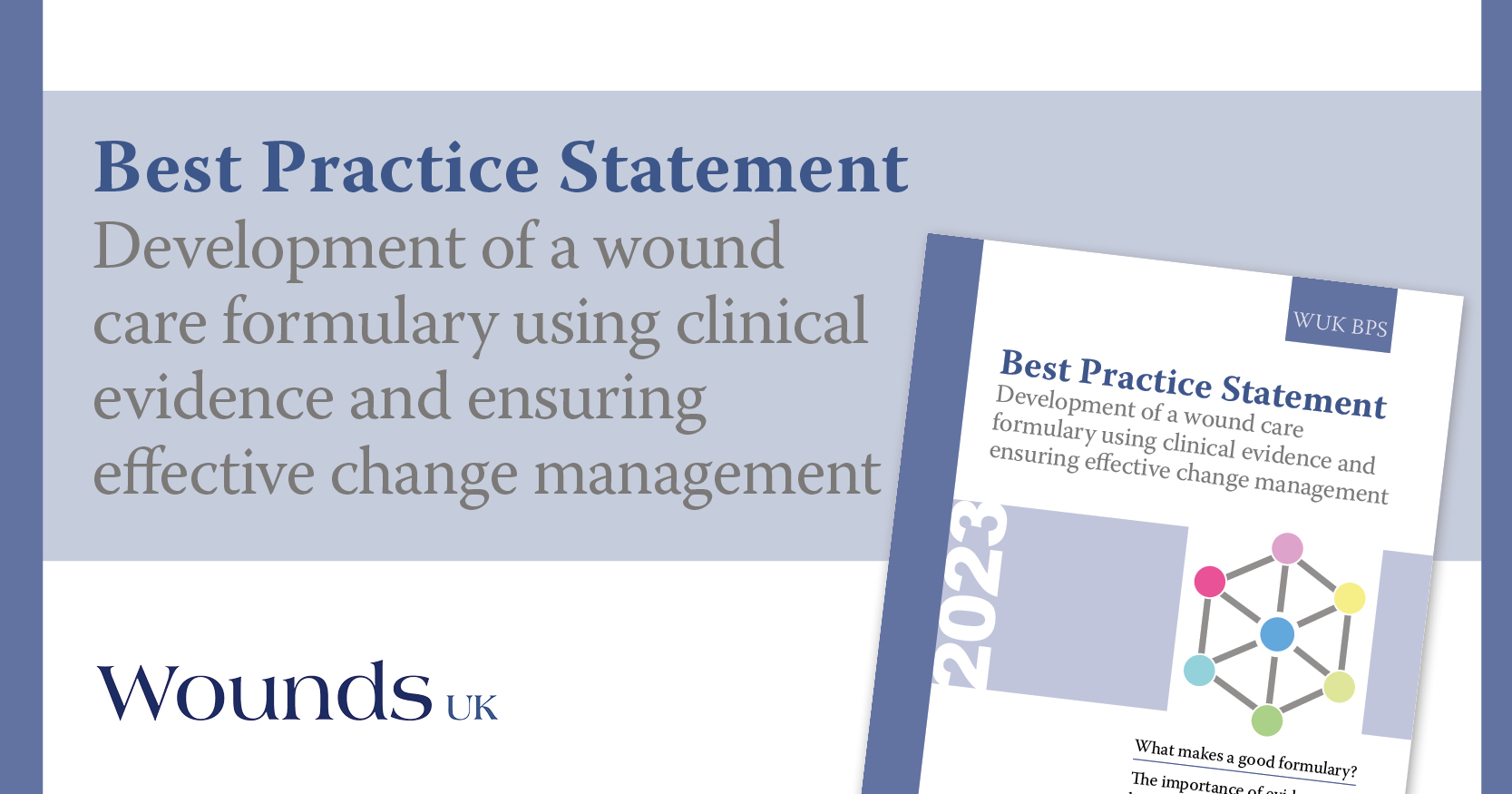In detained estates, it is essential wound care is standardised due to the unique complexities of this environment (Laver, 2023). NHS England and the Ministry of Justice work in partnership to secure positive outcomes for this population. Detained estates are inclusive of prison and immigration detention centres. As of 8 September 2023, there were 87,128 people in prison: 83,590 in the male estate and 3,538 in the female estate (UK Parliament, 2024). 16,031 people entered immigration detention in the year ending March 2024 (Gov UK, 2024). The average age of people in detained estates is rising, with those aged 15–20 years accounting for only 3,625, those aged 30–39 years accounting for over 28,524, and the remainder being over 40 years. Aldridge et al (2020) stated that prisoners are subject to health inequalities, experiencing poor health outcomes and limited access to care compared to the general population. Standardisation of healthcare can improve health-related quality of life outcomes and make effective use of resources in a timely and evidence-based method. Standardisation is not a new phenomenon (Trowbridge and Weingarten, 2001; Panz et al, 2005). Clinical pathways, care pathways, integrated care pathways and critical care pathways emerged in the 1980s being defined as providing a definitive approach for a specific medical condition or treatment process (Vanhaecht et al, 2010; McLachlan et al, 2020).
Non-healing wounds have been associated with a reduction in health-related quality of life and place a great burden on healthcare systems (Sen, 2021) with annual costs in 2017/2018 to the NHS reported to be £8.3 billion, of which £2.7 billion is related to healed wounds and £5.6 billion associated with unhealed wounds (Guest et al, 2020). Laver (2023) previously discussed a lack of confidence among staff in managing complex leg ulcers and other deteriorating wounds in detained estates that led to implementation of a wound care strategy.
This paper presents the results of a 6-month pilot following implementation of the strategy and a focused formulary in southeast England across two regions incorporating 10 facilities, one region commenced during the first 3 months, and the second followed for the final 3 months.
Pre-pilot stage
Following an internal audit, it was identified that there were inconsistencies in care and a lack of a standardised approach to wound care provision with limited care plans in place for patients with wounds. There was an abundance of wound care products, yet these were often used inappropriately due to a lack of staff understanding and having limited access to training for staff development. A review of the staff showed the majority were new to primary care and working in a detained estate environment with little knowledge and skills in assessing and managing a patient population with complex leg ulcers. Many staff members were unable to complete a holistic assessment, including the measurement of the ankle–branchial pressure index. Wound care clinics were frequently cancelled due to limited staff with the skills to complete wound assessments, leading to delayed treatment. High staff turnover created barriers to disseminating the new strategy and formulary and preparing staff for the pilot stage. In addition, changes to senior leadership teams resulted in access issues with the ordering platform, delaying staff in ordering stock recommended on the formulary and increasing waste in the absence of a stock management process.
Aims of the pilot
The overall aim of the pilot was to standardise wound management. Providing a standardised approach to wound assessment and management promotes timely wound healing, early recognition of signs of infection or wound deterioration, and effective pain management (Fletcher, 2008; Atkin et al, 2020; Tickle, 2021). Secondary aims were to increase awareness of the burden of wound care on services, increase knowledge and skills in wound management, increase confidence in choosing the correct wound care product and motivate teams to explore available training to develop skilled nursing provision on site.
Importance of standardising care
By standardising care, it was expected there would be a reduction in the requirement for patients to be transferred to local healthcare services to access wound care interventions. Arranging these visits is complex, as it requires removing staff from local establishments to provide prison escorts, with Davies et al (2020) reporting that a shortage of prison officers directly affects healthcare, as staff are unable to escort prisoners to appointments, both within prisons and for emergency or routine hospital attendance. Aldridge et al (2020) discussed the difficulties in planning visits outside of detained estates, stating that there are additional challenges for healthcare providers as they must work together with prison authorities to provide access to these external organisations. The NHS has been responsible for commissioning healthcare in the secure estate since 2006 (Nuffield Trust, 2020), which is expensive. Hunter et al (2024) estimate the costs of escorts and bed-watches (paid for by the NHS) as approximately £168 per hospital attendance and £2,232 per bed day. Reducing these visits away from detained sites would reduce costs, minimise staff loss and improve care for patients who could be managed in familiar surroundings, i.e. the detained estate. Additionally, due to waste highlighted in the pre-pilot report, it was anticipated that cost savings would be achieved through the effective and timely use of appropriate products.
Piloting the strategy and formulary
The pilot was implemented in October 2023 for a period of 6 months. All staff were presented with the strategy and formulary supported by bespoke workshops designed to upskill all staff and to discuss and explain appropriate use of the products recommended on the formulary. Formularies play an important role in underpinning the safe and effective use of treatments. They aim to promote evidence-based practice through providing a framework within which it is safe to practice assisting practitioners to differentiate between what may or may not be suitable for a particular patient or wound (Wounds UK, 2023). Standardising a formulary helps to remove unwanted variation in practice, promoting positive outcomes [Figure 1].
The formulary encouraged all clinicians to familiarise themselves with the appropriate product literature and manufacturers guidelines prior to use, while highlighting the importance of assessing for and documenting any allergies to the listed products or their ingredients to avoid potential harm. Furthermore, all patients were to be assessed within 24 hours of arrival at the detained estate, with any wounds documented and treated, and reassessed at each dressing change. Wound dressings could only be ordered for 2 weeks, after which the dressing regime required review.
Clinical care pathways, reflecting products on the formulary, were developed and implemented to guide staff on which products to use for different wound types and to understand expected outcomes. Pathways are essential to a formulary to support clinical decision-making and guiding care (Wounds UK, 2023). To support staff with the formulary and clinical care pathways, a quick guide and checklist (Wounds UK, 2023) were embedded in the educational resources [Table 1].
Workshops were offered on various days, both face-to-face and virtually, to encourage staff attendance. URGO clinical specialists supported the education and produced the formulary for dissemination across the pilot sites.
Education
The pre-pilot audit distributed to all healthcare staff (n=39) via SurveyMonkey incorporated 10 questions [Box 1].
All 39 staff responded to all questions with a mixture of nurses across all bands and paramedics [Figure 2]; respondents highlighted how often they managed a wound ranging from daily to less than monthly [Figure 3], the most common wound type was self-harm wounds [Figure 4].
In total, 37 staff (98%) reported they used evidence-based practice to influence decision-making, five staff (13%) reported they did not feel very confident when managing wounds with 19 (49%) stating they felt somewhat confident. Only nine (23%) reported they felt very or extremely confident in the application of compression with 15 (38%) stating they felt extremely or very confident in choosing the most appropriate dressing.
When asked do you feel you understand the benefits of the products at your disposal? 24 (62%) stated they would like to know more [Figure 5 and Figure 6].
Educational programme
An educational programme was implemented in addition to the workshops and offered virtually due to accessibility issues with face-to-face teaching because of the complexities of detained environments. This was to support knowledge and skills development led by a tissue viability nurse specialist throughout the pilot stage [Box 2]. All sessions were recorded so staff could view them again if required.
Underpinning staff education was a tool kit, offered both as a hard copy and online to read consisting of:
- Clinical pathways
- Risk assessment documentation
- Copy of the formulary
- List of contacts for support and advice
- Log in details for Procure (hard copy)
- Log in details for the online toolkit (hard copy).
On completion of the training all staff were able to access Procure for all training materials and the formulary booklet. All ordering of products had to be signed off by a named senior member of staff to ensure ordering was appropriate and to allow for evaluation of product use.
Implementing a customised ordering platform
A customised ordering platform, Procure, was used to improve governance surrounding stock control and compliance with the formulary. Procure is a simple and easy-to-use purchasing system that allows you to choose the supply route of your choice, either from the NHS supply chain or an alternative supplier. This allows clinicians to purchase wound care products and have them delivered directly to their place of work, simplifying product management and supporting your actions ensuring that only products on your formulary end up in the hands of your staff. Procure comes with access to URGO’s team of data analysts who can support the release of a monthly report function in line with the organisation’s needs and present in an easy-to-understand format. There is the capability to flag when anomalies occur to help support appropriate referrals and quality of care. The use of Procure reduces unwarranted variations in treatment and enhances formulary compliance by only allowing access to on-formulary products. There is no spend threshold or requirement to have agreed to specific formulary inclusions with Procure.
Discussion
All staff involved across the southeast were asked to complete an evaluation following completion of the pilot. Feedback indicated the strategy was clear and inclusion of a tool kit helped with decision-making. Staff commented that, although the training and educational programmes were helpful in increasing their confidence and preparing them to manage a range of wound types, it would have been beneficial if these sessions had been delivered prior to roll-out of the strategy and formulary, rather than during the pilot. They also stated that more practical demonstrations with company clinical specialists would be helpful to understand correct product choice, application and removal of dressings. They believed this would have enhanced delivery of the concept, and potentially reduce the number of staff questions received relating to the new formulary and pathways. Clinic posters for some of the pathways would have been useful to support communication of the project. For the next stage of the project all sessions will be delivered prior to implementation. To enhance learning an online capability framework: Tissue Viability Leading Change offered by URGO will be used allowing staff to self-assess their own levels of capability and seek appropriate further support and education to ensure safe and effective practice.
Staff noted that communication prior to the pilot had been verbal during site visits and through regional weekly meetings. Although this was perceived positively, some staff did not fully understand the pilot as they had been unable to attend the meetings, and the cascading of information was unstructured. As a result, all future sessions will be recorded for staff who cannot attend to watch later, and this will be made mandatory. Staff attrition remains an ongoing concern with identification of wound care champions and changes to senior leadership teams being a challenge, however recording of educational sessions and future recording of key information will allow new staff to access the resources in a timely manner. Weekly visits and telephone calls will be made to the sites to answer questions during the next phase.
Inappropriate use of wound products and excess waste had been a concern prior to the pilot. Monitoring dressing usage has been ongoing during the pilot using the Procure ordering system. This has demonstrated a reduction in waste reflecting the NHS clinical waste strategy (NHS England, 2023), where it is estimated through effective resource use and reduction in carbon impact, will achieve a 50% reduction in carbon emissions produced from waste management by 2026, and an 80% reduction by 2028–2032. Choosing the right product during the first assessment and continuing care helps to prevent waste by ensuring packaging has been examined for correct product, size, format and expiry date before opening (Wounds UK, 2023).
Pre-pilot there had been a lack of care plans documenting wound assessment and management. Post-pilot the number of accurate care plans being used had increased. Some sites did not have any wound care plans pre-pilot, whereas following the pilot all sites are now using the wound care plan templates with staff stating: “We have needed this for a long time and the pathways are so helpful”.
Standardising a wound strategy and formulary is essential to improve patient outcomes, support staff, and make cost effective use of resources. Reducing the number of visits to secondary care or community clinics for wound complications is essential as Edge et al (2020) in their qualitative study of prisoners accessing healthcare explored. Edge et al discussed delayed access to hospital appointments can be a harmful consequence of resource implications associated with transport and security, which could lead to significant adverse health outcomes and legal challenges. The ever-increasing ageing and increasingly vulnerable prison population (Mann, 2015) means healthcare should, as far as possible, be provided in detained estates to negate off-site visits that can cause anxiety and exacerbated stigmatisation of prisoners (British Medical Association, 2009).
Conclusion
The pilot has been successful with lessons learnt prior to a full roll-out. It has identified areas for development but has shown it is feasible to disseminate the strategy across multiple sites nationwide. The importance of working in partnership with URGO cannot be overstated, as they have assisted with formulary development, educational support for the pilot sites, and developed a bespoke ordering system to meet the needs of this complex healthcare area.







